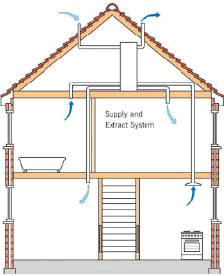Our Products

- Home
- Ventilation Systems
- Ventilation Services
-
Products
- HRV Units & Controllers
- Radial / Manifold Duct Systems
- Filters & Service Calls
- Insulated Ducting
- Low Energy Constant Volume Extract Fans
- Extra ventilation / Insulation Products and General Accessories
- Single Room Heat Recovery Units
- Renson Demand Control Systems
- Covid Solutions
- Airtight Tapes & Membranes
- Contacts
Mechanical Ventilation with Heat Recovery (MVHR)
Mechanical ventilation with heat recovery (MHRV) is another whole-house ventilation system which supplies fresh air to dry rooms and extracts stale air to wet rooms. Both air flows are ducted and driven by two fans, one on the supply side and one on the extract side. The key element of this system is that it uses a heat exchanger to transfer heat from the warm exhaust air to the fresh air, achieving up to 85% heat recovery. The reduction in heat losses due to ventilation is very significant and occupants comfort is also increased as the air supply is warmed before entering the rooms. The HRV unit which houses the heat exchanger and the fans is also equipped with filters which prevent outside dust entering the system and internal air particles depositing within the unit. Filtering the outdoor air, possibly up to removing pollen and other allergens, can be of great to people suffering of respiratory problems including asthma.

Source: Irish Building Regulations Part F
Since all the air supply is ducted, there is no direct opening to the outside and the risk of cold draughts is eliminated, provided the house is not draughty. It is in fact essential that the house is built airtight (recommended airtightness for new built ? 3 m3/m2,hr at 50 Pa) otherwise it is virtually impossible to balance the system (air supply rate = air extract rate) and get it to operate properly. In addition, energy efficiency gains achieved through heat recovery are largely negated by uncontrolled air infiltration.
The HRV unit should be selected to provide the air flow required in the house (nominal flow), on the extract and supply side, and achieve the highest level of heat recovery possible. The Building Regulations Part F (UK and Ireland) require that the system provides for an ongoing air renewal of approximately 0.4 AC/hr in our case-study house, and also specifies the extraction rate to be achieved in wet rooms (50 m3/hr in kitchen, 30 m3/hr in bathroom, 20 m3/hr in WC, etc.). The controls of the unit should allow varying the ventilation rate from minimum (when the house is not occupied) to boost when the house is very busy (party mode). It is also important that the fans are highly efficient to reduce electricity consumption.
Ducts should be kept as short as possible and the number of bends, reductions and other obstructions to air flow should be kept to a minimum to avoid the loss of air pressure and ensure good air distribution throughout the system. Rigid ducts (galvanised steel or PVC) and semi-rigid ducts (ridged polyethylene duct with internal smooth bore) are recommended, and flexible ducts are generally not as they create too much pressure drop and are prone to dirt deposits. The ducting should be planned in such a way that it can be cleaned every few years (5 years maximum).
Supply and exhaust duct sections from the HRV unit to the outside (assuming the unit is located inside) should be well insulated (50 mm for short duct lengths and 100 mm for duct lengths superior to 5 m), and the insulation material protected against vapour diffusion to avoid condensation on the duct. It is also very important to select a quiet HRV unit and apply all the precautions required to avoid noise pollution (max. 25 dBA in living and sleeping areas). Sound transmission through the ducting from the fans and between rooms should be eliminated by the use of silencers (sound absorbing sections of duct). The unit itself should be installed in utility spaces or in the attic away from bedrooms.
Information
Customer Service
Contact Us
A+ Ventilation Supplies / Ecoaer
Unit 4 Crossagalla Ind Est
Ballysimon Road
Limerick
V94 P273
Tel.: +353 (0)61 533996
Email: info@ecoaer.com
© A+ Ventilation Supplies 2024




